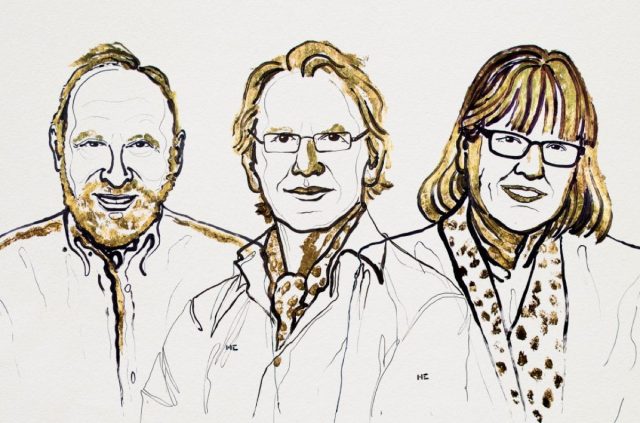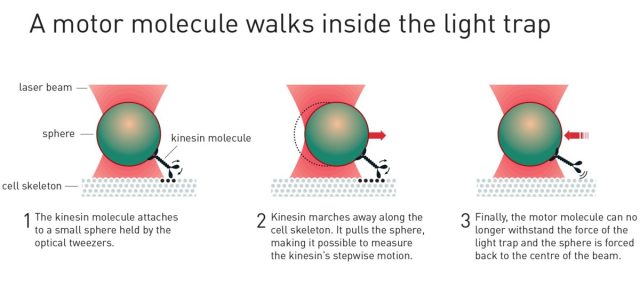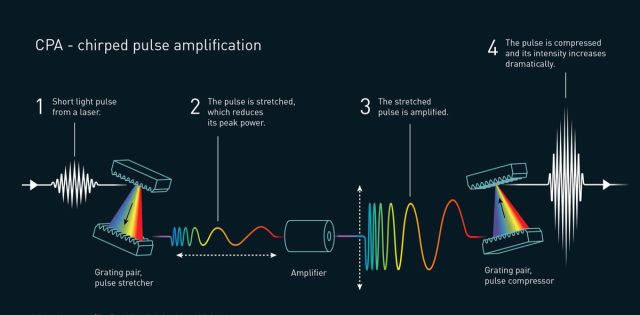It only took 55 years, but a third woman has finally been recognized with the Nobel Prize in Physics, the Royal Swedish Academy of Sciences announced today. Donna Strickland, a physicist at the University of Waterloo in Canada, shares this year's physics prize with Arthur Ashkin of Bell Laboratories and Gérard Mourou of École Polytechnique, Palaiseau, in France for creating "tools made of light."
The trio was honored "for groundbreaking inventions in the field of laser physics." Ashkin invented so-called "optical tweezers," tightly focused beams of light that can grab particles, atoms, and living cells; they're now a common tool in biological laboratories around the world. Mourou and Strickland won the prize for figuring out how to stretch and amplify laser light to create incredibly short, intense bursts of laser pulses. In its press release, the Academy cited the revolutionary nature of this combined work in "opening up unexplored areas of research and a multitude of industrial and medical applications."
When a reporter asked her how it felt to be only the third woman in history to be so honored, Strickland replied, "Really? Is that all? I thought there might have been more," adding, "I don't know what to say. I'm honored to be one of those women."
Marie Curie shared the prize in 1903 with Henri Becquerel and her husband Pierre Curie for their work on radioactivity. Maria Goeppert-Mayer shared the 1962 prize with E. Paul Wigner and Hans Jensen for her work on the shell structure of atomic nuclei.
Stimulated emission
This year's prize is the culmination of more than a century of prior research in fundamental physics. It took a while to fully develop the underlying technology, but lasers are pretty much ubiquitous these days. Lasers are in our DVD players and supermarket scanners, used for optical communications and data storage, and for tattoo removal and eye surgery, not to mention their usefulness to the manufacturing industry. So we tend to take them for granted and forget how much these ingenious devices continue to transform science and technology.

Albert Einstein first broached the possibility of so-called "stimulated emission" in a 1917 paper, the foundational basis for lasers. It's possible to apply intense flashes of light or electricity to atoms or molecules in a given medium (say, a crystal like ruby or garnet or some kind of gas or liquid). This "pumps" them up so that there are more atoms in an excited state than in their natural ground state. If another incoming photon strikes an excited atom, it can knock that atom back to its ground state. The atom will emit a second photon of the same frequency, moving in the same direction as the bombarding photon. That new photon may strike another energized atom in turn, prompting the release of another photon, and so on, until all the atoms suddenly discharge in a rapid chain reaction.
Who actually invented the laser is a point of some contention. Bell Laboratories physicists Charles Townes and Arthur Schawlow are most often associated with the invention, although they shared their patent rights with Columbia University scientist Gordon Gould after the latter filed a successful lawsuit. (They did invent its predecessor, the maser, which operated only in the microwave regime.)
Theodore Maiman is another physicist often associated with inventing the laser while working at Hughes Aircraft Company in the 1950s and 1960s. He built upon the 1958 theoretical work of Townes and Schawlow to create the first working, solid-state laser. It used a ruby crystal as the lasing medium and was successfully demonstrated in May 1960. Townes himself later acknowledged that "Maiman's laser had several aspects not considered in our theoretical paper nor discussed by others before the ruby demonstration." The laser has been a boon to science ever since.
A trap for light

Optical tweezers once were firmly in the realm of science fiction, most notably Star Trek's trademark tractor beams. But Arthur Ashkin had a dream of one day using beams of laser light to move around small objects. Light energy isn't strong enough to move a human being, much less a starship, but he reasoned that it might suffice to push around small particles. He managed to do just that with tiny clear spheres. And he noticed that the spheres seemed to gravitate toward the most intense middle portion of the laser beam.
This happens because the intensity of the beam, no matter how tightly focused, will decline from the center out to the sides, so the laser light will exert uneven pressure on the spheres, pushing them toward the center. It's even possible to levitate those spheres by pointing the laser beam upwards. During the press conference, one of the Nobel committee members memorably used a hair dryer to suspend a ping-pong ball in the air to demonstrate how this works.
Ashkin later added one final twist: he used a strong lens to further focus the laser light so the particles were trapped at the beam's center. Voilà! He had optical tweezers. After several more years of work, he eventually managed to trap individual atoms. It takes more force to grab an atom, which also has its own natural heat vibrations. Ashkin found he could overcome those challenges by combining optical tweezers with other methods for laser cooling and trapping of atoms.
As for those pioneering biological applications, they came about almost by chance. Ashkin kept experimenting with trapping ever-smaller particles with his optical tweezers, including samples of mosaic virus. One night, he left the samples open. In the morning, he noted lots of larger particles in the sample under the microscope: bacteria. And the bacteria also got caught in the light trap whenever they swam near it. The intensity of the green laser beam killed those wayward bacteria, but by switching to infrared light, he found the bacteria could survive and multiply. Laser tweezers are now a laboratory standard in the life sciences.
Chirped pulses

Lasers have had many potential applications, but there were limits to how intense the beams (i.e., how short the wavelength of the light) could be. Above a certain energy threshold, the beams would destroy the amplifying medium. Strickland was a graduate student in Mourou's laboratory at the University of Rochester in the 1980s when they realized they could overcome this difficulty by stretching a short laser pulse to lower its peak power before amplifying it. That way they could amplify the pulse without destroying their amplifying material. After that, the pulse could be squeezed again, packing more light into a tiny area of space, thereby dramatically increasing the pulse's intensity.
The technique is known as chirped pulse amplification (CPA), and it's now widely used in physics, chemistry, and medicine. For instance, those intense ultrashort pulses make it possible to capture interactions between molecules and atoms, which take place in a millionth of a billionth of a second. Think of it as the world's fastest camera. High-intensity lasers can also turn electrical insulators into conductors, precisely cut or drill holes in many different materials, or perform laser eye surgery. And there are plenty more applications on the horizon.
The Royal Swedish Academy of Sciences recently announced an initiative to encourage more diversity in nominations with regard to gender, geography, and areas of research. That's very good news. Hopefully it won't be another 55 years before we see another woman—or a member of any other underrepresented group—receive the Nobel Prize in Physics.
[contf] [contfnew] 
Ars Technica
[contfnewc] [contfnewc]






